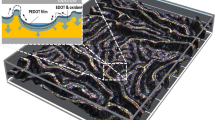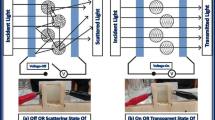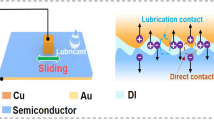Abstract
The polarizer film is an important component in the Thin-film-transistor liquid crystal displays (TFT-LCDs), which is a multilayer composite film developed by using dichromatic material stretching film technology. However, the polarizer film is liable to fail in hygrothermal circumstances. In this work, we analyzed a polarizer film shipped from China to Brazil that failed due to the ocean environment. By analyzing the structure, composition, and crystallinity of the polarizer film, Polyvinyl Alcohol (PVA) layer of the polarizer film has larger crystallinity, and there are bonding pores between the PVA layer and the Triacetyl Cellulose (TAC) layer. Under the action of the marine environment, the I3− ions in the PVA layer were released, resulting in the separation of PVA layer and TAC layer at the bonding pores, and then forming bright spots. Furthermore, through analyzing the marine environment and simulated environmental experiments, it was determined that the thermal environmental factor induces the release of I3− ions in the PVA layer. Finally, based on the failure process and failure mechanism of the polarizer, improvement measures to prevent the occurrence of bright spots of the polarizer are proposed.















Similar content being viewed by others
References
J. Ma, X. Ye, B. Jin, Structure and application of polarizer film for thin-film-transistor liquid crystal displays. Displays. 32(2), 49–57 (2011)
J.R. Manders, L. Qian, A. Titov, J. Hyvonen, J. Tokarz-Scott, K.P. Acharya, Y. Yang, W. Cao, Y. Zheng, J. Xue, P.H. Holloway, High efficiency and ultra-wide color gamut quantum dot LEDs for next generation displays. J. Soc. Inform. Disp. 23(11), 523–528 (2015)
Y. Wei, H. Zhou, Y. Chen, Y. Ding, J. Dong, X. Zhang, Anti-parity-time symmetry enabled on-chip chiral polarizer. Photon. Res. 10(1), 76–83 (2022)
J. Ma, Advanced MEMS-based technologies and displays. Displays. 37, 2–10 (2015)
X.U. Shi-Ying, The technology and its trends of tft-lcd polarizer. Adv. Disp. 9, 25–31 (2010)
R. Chen, B. Bai, Z. Zhou, Low-loss hybrid plasmonic tm-pass polarizer using polarization-dependent mode conversion. Photon. Res. 8(7), 1197–1202 (2020)
H. Xu, D. Dai, Y. Shi, Anisotropic metamaterial-assisted all-silicon polarizer with 415-nm bandwidth. Photon. Res. 7(12), 1432–1439 (2019)
C.S. Lin, J.T. Huang, P.Y. Wu, Y.L. Lay, H.J. Shei, Improvement of TFT-LCD’s polarizer plate bubble problem using a preheating-process. Sci. Iran. 23(2), 566–574 (2016)
K. Koo, W.S. Lyoo, T.W. Son, Y.M. Park, Improvement of the durability against high humidity of pva-iodine polarizer film by low temperature plasma treatment. J. Textile Mach. Soc. Jpn. 58(9), T109–T114 (2005)
F. Inagaki, I. Harada, T. Shimanouchi, M. Tasumi, The resonance Raman spectrum of the poly (vinyl alcohol)-iodine complex. Bull. Chem. Soc. Jpn. 45(11), 3384–3388 (1972)
H. Noguchi, H. Jyodai, S. Matsuzawa, Formation of poly (vinyl alcohol)–iodine complexes in solution. J. Polym. Sci. Part B: Polym. Phys. 35(11), 1701–1709 (1997)
Q.G. Zhang, Q.L. Liu, Y. Chen, J.Y. Wu, A.M. Zhu, Microstructure dependent diffusion of water–ethanol in swollen poly (vinyl alcohol): a molecular dynamics simulation study. Chem. Eng. Sci. 64(2), 334–340 (2009)
A. Tanioka, D. Fu, Reaction of polyvinyl alcohol and iodine. Vinylon Commun. 17(3), 44–49 (1997)
P.H. Wang, Y.R. Chang, D.J. Lee, Shape stable poly (vinyl alcohol) hydrogels with immobilized activated sludge at repeated dry-rewet cycles. Biores. Technol. 289, 121662 (2019)
Y. Takahashi. Neutron structure analyses of poly(vinyl alcohol) and polyethylene-d4. Polymer Preprints (38-2). (1997)
A. Melocchi, N. Inverardi, M. Uboldi, F. Baldi, A. Maroni, S. Pandini, A. Gazzaniga, Retentive device for intravesical drug delivery based on water-induced shape memory response of poly (vinyl alcohol): design concept and 4D printing feasibility. Int. J. Pharm. 559, 299–311 (2019)
N. Takahashi, T. Kanaya, K. Nishida, Y. Takahashi, M. Arai, Rheo-SANS study on gelation of poly (vinyl alcohol). Physica B. 385, 810–813 (2006)
K. Lewandowska, Miscibility and thermal stability of poly (vinyl alcohol)/chitosan mixtures. Thermochim. Acta. 493(1–2), 42–48 (2009)
P.N. Ghoderao, D. Dhamodharan, S. Mubarak, H.S. Byun, Phase behavioral study of binary systems for the vinyl Benzoate, vinyl pivalate and vinyl octanoate with carbon dioxide at high-pressure. J. Mol. Liq. 358, 119131 (2022)
C.C.Q. Wong, A.Y. Yap, C.W. Liew, The effect of ionic liquid on the development of poly (vinyl alcohol)(PVA)-based ion conductors for electric double layer capacitors application. J. Electroanal. Chem. 886, 115146 (2021)
H. Li, Y. Wang, & Y. Zhong, (2013). Progress in r&d of polarizing film using in tft-lcd. Synthetic Technology & Application
Author information
Authors and Affiliations
Corresponding author
Additional information
Publisher's Note
Springer Nature remains neutral with regard to jurisdictional claims in published maps and institutional affiliations.
Rights and permissions
Springer Nature or its licensor (e.g. a society or other partner) holds exclusive rights to this article under a publishing agreement with the author(s) or other rightsholder(s); author self-archiving of the accepted manuscript version of this article is solely governed by the terms of such publishing agreement and applicable law.
About this article
Cite this article
Tang, Y., Zhu, G., Li, Y. et al. Failure Analysis of Polarizer of Liquid Crystal Display. J Fail. Anal. and Preven. 23, 2673–2682 (2023). https://doi.org/10.1007/s11668-023-01800-x
Received:
Accepted:
Published:
Issue Date:
DOI: https://doi.org/10.1007/s11668-023-01800-x




